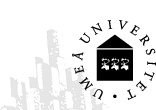A few research projects
(The links may be used to get postscript versions of the papers.)
- Disorder Driven Melting of the Vortex Line Lattice,
P. Olsson and S. Teitel (Rochester University)
Background: A magnetic field
that penetrates a clean type-II superconductor will be split into flux
tubes each with one flux quantum. Associated with these flux tubes is
a set of vortices. These vortices will at low temperatures order into
a triangular lattice - an Abrikosov lattice.
A current sent through such a system will exert a force on the vortices.
This force leads to vortex motion and thereby a voltage drop. The
effect is therefore to have dissipation even though the system is
superconducting on the microscopic scale.
An important question is how this behavior is changed by the presence
of disorder. This is the subject of innumerable both experimental and
theoretical papers. One suggestion is the existence of a "vortex
glass phase" where the random disorder conspires with the vortex
interaction to "pin" the vortices to the impurities and thereby make
them immobile.
In Disorder Driven
Melting of the Vortex Line Lattice , P. Olsson and S. Teitel, we
study this question by large-scale Monte Carlo simulations of a
frustrated 3D XY model. The main result is that the Abrikosov lattice
melts in a first order transition at a critical pinning strength which
is independent of temperature. The phase boundary between the
Abrikosov lattice and the disordered phase therefore turns parallel to
the temperature axis. Above this transition line the helicity modulus
parallel to to applied field vanishes, which means that there is no
true phase coherent vortex glass phase.
- Anomalous dimension of the Lattice London superconductor and
vortex loops in the 3D XY model,
Peter Olsson
Background: The 3D XY model is really a model of superfluid
helium. In a description of a superconductor there is an additional
effect due to the fact that the Cooper pairs are charged. Currents in
the system give rise to a magnetic field and this effect has
to be included in a detailed description of the transition. This
model is the Lattice London Superconductor (LLS). (In most cases it
is, however, justified to neglect this effect.)
There does exist a rather direct relation between the Lattice
London Superconductor and the 3D XY model because of a duality
transformation. The LLS is similar to a 3D XY model with the
temperature scale inverted, i.e. the high-temperature properties of
the XY model may be obtained from the low-temperature properties of
the LLS model and vice versa. This means that some information about
the more complicated LLS may be determined from the properties of the
3D XY model.
This duality relation has been used by others to determine the critical
exponent, eta, in the LLS model from the properties of the vortex
loops in the 3D XY model. They found eta=-0.18. The negative value of
eta is both interesting and suprising.
In Critical exponent
eta of the lattice London superconductor and vortex loops in the 3D XY
model , (P. Olsson) we perform a direct determination of the same
exponent and find an even more negative value, eta=-0.79. We also
examine the indirect (vortex loops in 3D XY) method but conclude that
- The result depends on details as how one treats vortex loop
intersections in the tracing out of the vortex loops.
- The result by Nguyen and Sudbo (eta = -0.18) is incorrect because
of bad precision in their Monte Carlo data.
- The results from analyses of more precise Monte Carlo data seem
to be sensitive to the density of vortex loops. The correct result can
at most be obtained in the limit of low vortex density.
|
